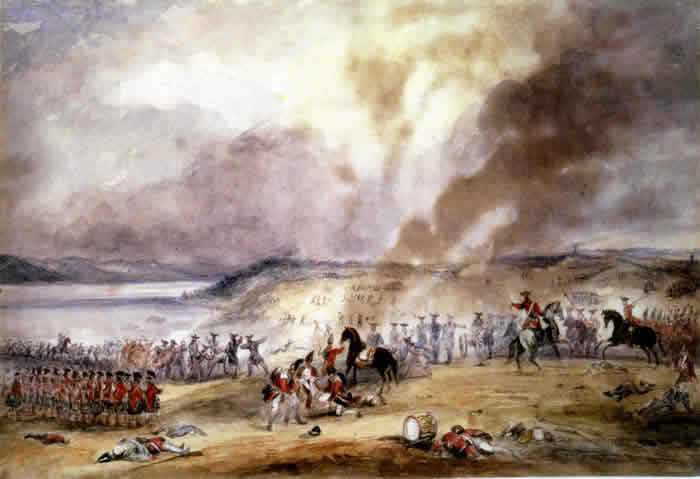

BATTLE OF SAINTE-FOY
Course / Assessment
Murray was impatient, and rather than wait for the enemy he left his favourable position and ordered an attack. The heart of the French Army was still advancing and the General wanted to attack before it had time to form. This strategy was at first quite successful. Bourlamaque, an officer under Lévis' command, was taken by surprise and could not position his men favourably. The first British attack resulted in several casualties and a wounded Bourlamaque had to pull out.

Although at first the battle seemed favourable, the snow and mud slowed down the progress of the British troops. Moreover, the Troupes de la Marine and the French Militia knew their way around better than the British did, and since they were more familiar with roads, they arrived as a back up force. Although there was some confusion when it came to follow orders, these forces dealt the British Army some hard blows by attacking them with bayonets, and they finally succeeded in breaking the line of attack142.
Intense fighting also took place at the Dumont mill located north of the promontory, along the chemin Sainte-Foy. Some 10 metres high, with strong walls, the mill offered excellent protection to the fighting soldiers, making it a coveted location. At first the mill was taken by the French Grenadiers before they were dislodged by the British Light Infantry. The Régiment de Béarn counterattacked, and once again the French gained control of the place until the British Infantry 35th Regiment Grenadiers managed to reverse the situation143. These combats were waged hand-to-hand, using bayonets and knives.
Meanwhile, Lévis attacked on his right and thus initiated a dual surrounding manoeuver. The British artillery, which until then had made up for higher enemy numbers, was increasingly less efficient. The work of the artillerymen was in fact complicated by the snow and the mud, which made the transport of ammunitions very difficult.
Faced with such pressure, Murray had no other choice but to order his troops to retreat inside the walls. After over three hours of combat and after several men had fallen under enemy fire and bayonet attacks, the British Army turned back and retreated.
The assessment of losses for the last battle of the siege of Québec is higher than for the Battle of the Plains of Abraham. For his part, Murray assessed his losses at 1,104 (dead, wounded and missing). On the French side, Lévis reported 833 victims, including 193 who died in combat or from their wounds144.
